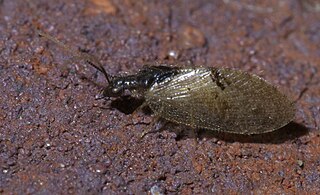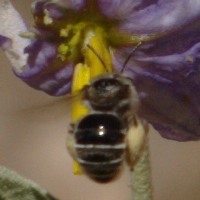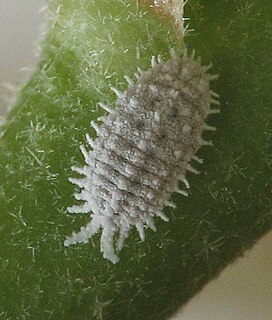
Mealybugs are insects in the family Pseudococcidae, unarmored scale insects found in moist, warm habitats. Many species are considered pests as they feed on plant juices of greenhouse plants, house plants and subtropical trees and also act as a vector for several plant diseases. Some ants, however live in symbiotic relationships with them.

Annona is a genus of flowering plants in the pawpaw/sugar apple family, Annonaceae. It is the second largest genus in the family after Guatteria, containing approximately 166 species of mostly Neotropical and Afrotropical trees and shrubs.

Withania somnifera, known commonly as ashwagandha, Indian ginseng, poison gooseberry, or winter cherry, is a plant in the Solanaceae or nightshade family. Several other species in the genus Withania are morphologically similar. Although thought to be useful as a medicinal herb in Ayurveda and sold in many countries as a dietary supplement, there is insufficient scientific evidence that it is safe or effective for treating any disease.

Cryptolaemus montrouzieri, common name mealybug ladybird or mealybug destroyer, is a ladybird species.
Putoidae is a family of scale insects commonly known as giant mealybugs or putoids. There is probably a single genus, Puto, containing about sixty species. The genus name Macrocerococcus has also been used but it is now considered to be a synonym of Puto. The genus Puto was formerly classified as a member of the Pseudococcidae; however, it so significantly differed from the rest of the Pseudococcidae that it was accorded its own family Putoidae.
Phenacoccus manihoti is a scale insect species.
Sympherobius californicus is a species of brown lacewing in the family Hemerobiidae. It is found in Central America, North America, and Oceania. The species was introduced to New Zealand to prey on aphids and mealybugs affecting crops, first noted in 1936, however was not able to be established.

Sympherobius barberi, or Barber's brown lacewing, is a species of brown lacewing in the family Hemerobiidae. It is found in Europe & Northern Asia, Central America, North America, Oceania, and South America. The species was introduced to New Zealand to prey on aphids and mealybugs, first noted in 1936, however was not able to be established.
Lema solani is a species of leaf beetle in the family Chrysomelidae. It is found in North America.

Exomalopsis solani, the solanum exomalopsis, is a species of bee in the family Apidae. It is found in Central America and North America.

Phenacoccus is a genus of mealybugs in the family Pseudococcidae. There are at least 180 described species in Phenacoccus.

Diomus terminatus is a species of lady beetle in the family Coccinellidae. It is found in throughout eastern North America. It is brown and oval-shaped, with a reddish tinge at the back portion of its elytra, and about 1.5 to 2 mm. It is covered in gold-colored setae, giving it a slightly hairy appearance. Its prey likely includes aphids, scale, and mealybugs.
Irbisia solani is a species of plant bug in the family Miridae. It is found in North America.
Rhynocoris longifrons is a species of assassin bug in the family Reduviidae. It is a predator of other insects and is found in Asia. Crops on which it is found feeding on pests include pigeon pea, cardamom and peanuts. The insects are potentially useful in biological control because they are more resistant to pesticides than are the pests they consume.

Phenacoccus solenopsis, the cotton mealybug or solenopsis mealybug, is a species of mealybug in the family Pseudococcidae. Having originated in North America, it has spread to other parts of the world and become a major pest of cotton crops.









